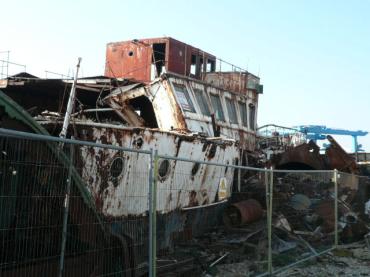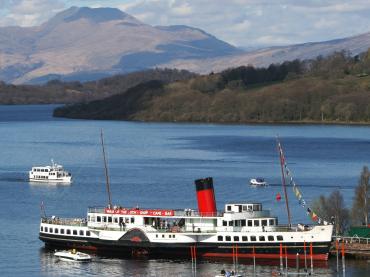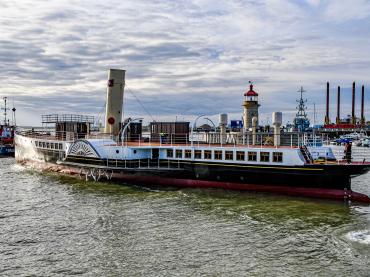


Details
Construction
Dimensions
History
WAVERLEY is not only the last Clyde paddle steamer built, but also the last sea-going paddle steamer operational in the world. Built for the London & North Eastern Railway (LNER) to replace war losses, she was launched on 2 Oct 1946 and berted in the River Kelvin for fitting out. She moved to her base at Craigendoran for her maiden voyage on 16 June.
WAVERLEY's main excursion route in the early days was the cruise from Rothesay to Loch Goil and Loch Long where most passengers left the ship at Arrochar, to journey over to Tarbet, rejoining WAVERLEY at Craigendoran. Her weekend duties took her into Loch Fyne and the Kyles of Bute.
In October 1947, she finished her season and was laid up for the winter in Bowling Harbour. She was painted in the traditional LNER colours (her funnels with a black top, white stripe and red bottom), but this original colour scheme only lasted one season for in 1948, the railways were nationalised and the railway steamers' ownership passed to the British Transport Commission (BTC). WAVERLEY's funnels were repainted in the buff (pale yellow) with black top colours of the Caledonian Steam Packet Co. (CSP), the division of BTC that operated the Scottish steamers.She continued to operate in the Firth of Clyde and the adjoining lochs on both excursions and regular ferry services.
Between 1949 and 1964 she had a variety of winter duties, often replacing another ship that was being overhauled, or she was the spare vessel ready to cover for others in an emergency. In the main season, her routes were extended to include the Isle of Arran in 1953 and from 1958 onwards, there was also a cruise up the Clyde to Glasgow (Bridge Wharf) from the coastal resorts. In 1965 her hull was repainted in monastral blue, and red metal lions were emblazoned on the funnels.
By 1970, she was the last seagoing paddle steamer in the world. By 1971, WAVERLEY was one of only two large excursion vessels left on the Clyde and was based at Gourock. In 1973, CSP became part of Caledonian MacBrayne Ltd and her funnels had another makeover, becoming red with a yellow circle encompassing the lions, but this year was to be her last season. WAVERLEY was sold on 8 August 1974 to the Paddle Steamer Preservation Society and refitted for the WAVERLEY Steam Navigation Company and her livery was returned to the LNER colour scheme of red, white and black. In 1975, she re-entered service on the Clyde, sailing at weekends from Glasgow and in mid-week from Ayr. In 1977, she spent a week on excursions from Liverpool and the success of this led to over a month being spent on the South Coast in the following year. In 1981, she was fitted with a new boiler and embarked on her first full season of Round Britain cruising, with the peak summer weeks spent back on the Clyde.
In her 1990/91 winter refit, the paddle wheels were replaced and a major £7m two-stage rebuild was undertaken in early 2000 and winter 2002/03 in Great Yarmouth with the support of the National Heritage Lottery Fund. WAVERLEY continues to be maintained in excellent condition and is the last seagoing paddle steamer in the world, fully restored and painted in her original LNER colours. She now runs cruises and charter days out around the British Isles and in 2015 celebrates 40 years of service under her current owner.
New boilers installed in 2020. 2023 Waverley continues to cruise around the UK coast with a busy schedule of cruises.
Source: Paul Brown, Historic Ships The Survivors (Amberley, 2010), updated Feb 2011. Owner update, Aug 2023.
Key dates
-
1946/1947
Built by A. & J. Inglis, Glasgow
-
1947/1970
Cruised the River Clyde and Western Scotland
-
1970
Became the last remaining sea going paddle steamer
-
1973
Acquired by Caledonian MacBrayne
-
1974
Acquired by Paddle Steamer Preservation Society
-
1981
Fitted with new boiler and commenced cruising round coast of Britain
-
2000/2003
Rebuilt with support from Heritage Lottery Fund
-
2021
Completed a further crowdfunder and successfully reached her target of £350,000 thanks to donations from over 2,700 people. She is now operational again, cruising the Firth of Clyde.
Grants
-
2001/02
The Heritage Lottery Fund awarded £3,028,000 for repair and restoration
-
1996/97
The Heritage Lottery Fund awarded £2,689,000 for repair and restoration
Sources
Brouwer, Norman J, International Register of Historic Ships, Anthony Nelson, pp182, Edition 2, 1993
Lloyds Register of Ships 1997-8, Lloyd's of London, pp1670, Volume A-G, 1998
Sullivan, Dick, Old Ships, Boats and Maritime Museums, Coracle Books, 1978
Steamboat Register: An illustrated Register of surviving steam vessels in the British Isles, Steam Boat Association of Great Britain, Edition 6, May 1994
Hamer, Geoffrey, Trip Out 1995/6 - A Guide to the Passenger Boat Services of the British Isles, G P Hamer, 1995
Lister, David, Daily Mail: A full head of steam on paddle boat, 6 January 1998
Tweedle, Neil, Daily Telegraph: Actors go down well upon steamer stranded at sea, 15 June 1999
James, Nick, Maritime Heritage: Born-again Waverley, Sept-Oct Volume 2.3, 1998
Ships Monthly: UK Excursion Guide 2000, August 2000
Ships Monthly: Still in Steam: Paddle Steamer Waverley, April 1980
Transport Trust: Make or break for Waverley, Edition 103, 2011
Waverley Times Facing up to rebuild future, 1997
Own this vessel?
If you are the owner of this vessel and would like to provide more details or updated information, please contact info@nationalhistoricships.org.uk















